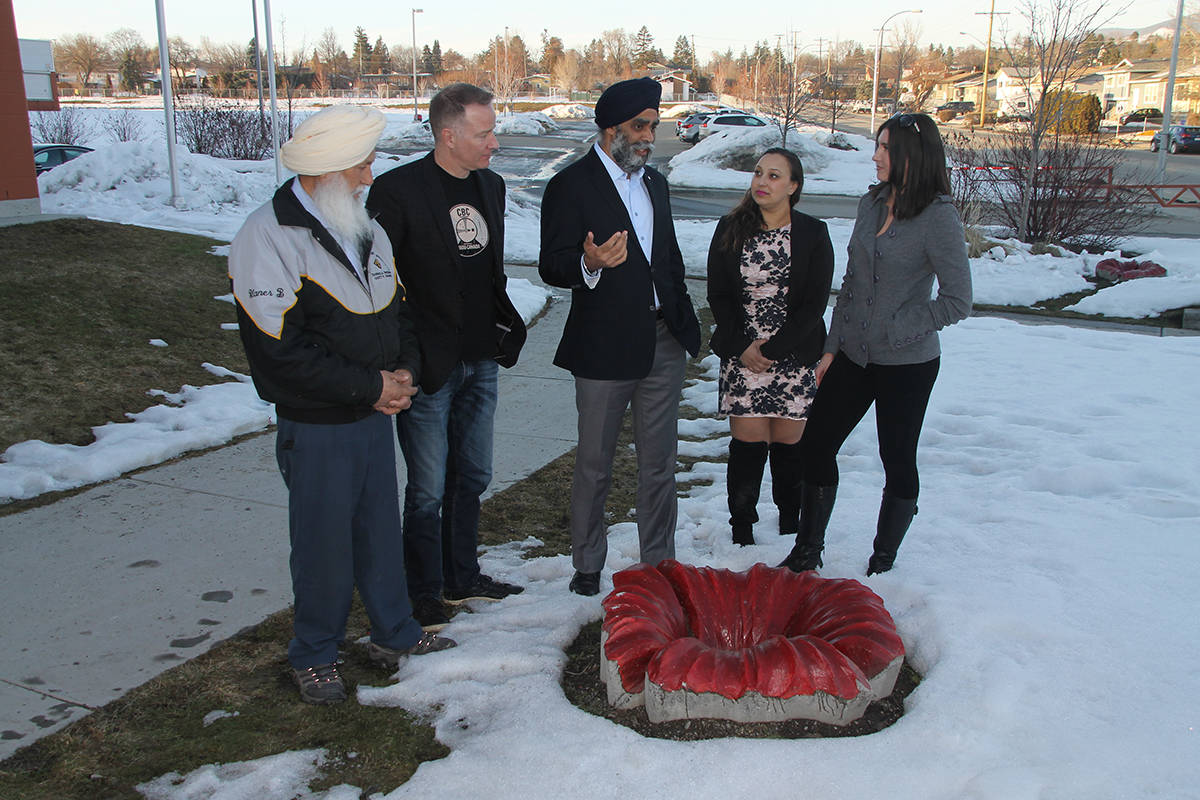A Vernon art project, says Canada’s Defence Minister, is a perfect example of how nations came together in times of the world wars, and a great message of unity and diversity.
Harjit Sajjan is visiting the Okanagan this week and took time from his schedule to travel to Vernon with Kelowna-Lake Country MP Stephen Fuhr to meet artist Amanda Shatzko, who created the Poppy Project housed at her alma mater, Vernon Secondary School, in 2016.
“It’s so important to tell the stories of the sacrifices that were made by our service men and women during the great wars,” said Sajjan, who has ties to Vernon. He was a summer student at the Vernon Army Camp in 1989, and returned three years later to instruct at the camp.
“When you start putting your own thoughts into it, it really brings a whole new perspective into it. You can tell that now, everything from how the poppies are created, the pictures that were selected and more importantly, representing the different groups as well from Indigenous to the contribution of women and the Sikh soldiers.
“I’m really proud of you (to Shatzko), and the leadership and the students who did this project. It’s so important we remember.”
The Poppy Project is a tribute to those who fought for the freedom of Canadians. The sculptures – five made out of stone, each four-foot in diameter, 1.5 feet tall and weighing in at about 750 pounds – were created to honour all nationalities and cultures from Greater Vernon involved in international conflicts.
The poppies represent the five generations that have passed since the Battle of Vimy Ridge in 1917. The images in the centre of the flowers can be viewed day or night, symbolizing their eternal presence.
Shatzko, current president of the local chapter of the BC Arts Council, had already been commissioned to do a public art sculpture in 2015 when she had a conversation with Vernon city councillor Dalvir Nahal and Steven Purewal, curator of Vancouver’s Duty, Honour and Izzat Punjabi Heritage exhibition.
After discovering the story of the Sikhs’ stand with the Canadian Expeditionary Force at Flanders Field in the First World War during the exhibit’s showing in Kelowna, Shatzko added an additional poppy featuring a turbaned soldier to the Poppy Project.
RELATED: Poppies pop up at Vernon Secondary School
“Showing support to the veterans and everybody in the First and Second World Wars, and even beyond that to the veterans up to nowadays in all the other wars who have fought for freedom for Canada, was the idea behind the project,” said Shatzko. The rendering of the images in the centre of the poppies further honours the war veterans.
“They are actually made out of phosphorous and paint so the images will technically glow in the dark. It was done that way to represent the eternal flame of the spirits and souls of people who have sacrificed for our freedoms.”
The Sikhs, the religious community to which Sajjan belongs, have made Canada their home for more than 100 years and are one such community whose wartime sacrifices have long gone unrecognized across the country.
“Beyond history books to be read in private or even historical movies to be watched with friends, public exhibitions and memorials hold a different promise in connecting with people with any number of disparate experiences, memories or even awareness; they can stir unique dialogues between strangers - and these poppies are no exception,” said Nahal, accompanied at Monday’s meeting with Sajjan by her father, Tara.
“It was a great privilege to have the country’s first inclusive memorial located here in our city. I hope it proves to be an inspiration for other communities to reflect on the diversity of Canada so that they too may honour all those that stood united and made the ultimate sacrifice to preserve the democracies and freedoms we enjoy today.
“I feel its setting amongst the high school youth of our city foretells a positive inclusive future at a time when cities in other parts of North America seem to be getting swallowed up in growing divides.”
The Punjab’s Lahore Division landed five months before the Canadians and helped save the beleaguered British expeditionary force from annihilation in the first Battle of Ypres (October 1914), and then, in the second battle of Ypres (April 1915), stood shoulder to shoulder with Canada amidst the poppies even as the first major chemical weapons attack in history wreaked havoc upon them all.
“Prejudice in the past has led to a non-inclusive narration of the events of First World War in Canada,” said Purewal. “When you see that these ‘others’ fought shoulder to shoulder with our own in the good fight, it becomes a little harder to dehumanize them as the ‘other.’
“Our exhibit narrates stories that prove that no matter skin colour, heritage, or faith; courage, integrity, duty and friendship can be found in all of us and that these are the ties that should bind us as Canadians.”
Sajjan was clearly moved by the project.
“It’s a great honour to have him in our little town in the North Okanagan,” said Shatzko.
roger@vernonmorningstar.com
Like us on Facebook and follow us on Twitter.
